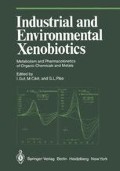Abstract
In the current view of the mechanism of CC14-induced hepatic necrosis, a free-radical metabolite presumably is generated in the liver during the complexing of CC14 with cytochrome P-450 and the subsequent reduction of the complex by NADPH and cytochrome P-450 reductase (e.g., see Reiner and Uehleke 1971; D’Acosta et al. 1973; Recknagel and Glende 1973; Sipes et al. 1977; Masuda and Murano 1978). The highly reactive free-radical is believed to be the actual toxic species causing hepatocellular damage, either by stimulating lipid peroxidation (e.g., see Recknagel and Ghoshal 1966; Slater 1972; Recknagel and Glende 1973) or by binding covalently to essential cellular macromolecules (e.g., see Reynolds 1967; Rao and Recknagel 1969; Castro and Gomez 1972; Recknagel and Glende 1973; Villarruel et al. 1977) or possibly by both mechanisms.
Access this chapter
Tax calculation will be finalised at checkout
Purchases are for personal use only
Preview
Unable to display preview. Download preview PDF.
References
Bend JR, Hook GER, Easterling RE, Gram TE, Fouts JR (1972) A comparative study of the hepatic and pulmonary microsomal mixed-function oxidase systems in the rabbit. J Pharmacol Exp Ther 183: 206–217
Boyd MR (1976) Role of metabolic activation in the pathogenesis of chemically induced pulmonary disease: Mechanism of action of the lung-toxin furan, 4-ipomeanol. Environ Health Perspect 16: 127–138
Boyd MR (1977) Evidence for the Clara cell as a site of cytochrome p-450-dependent mixed-function oxidase activity in lung. Nature (Lond.) 269: 713–715
Boyd MR (1980) Biochemical mechanisms in chemical-induced lung injury; roles of metabolic activation. CRC Crit Rev Toxicol 7: 103–176
Boyd MR, Burka LT (1978) In vivo studies on the relationship between target organ alkylation and the pulmonary toxicity of a chemically reactive metabolite of 4-ipomeanol. J Pharmacol Exp Ther 207: 687–697
Boyd MR, Burka LT, Wilson BJ, Sasame HA (1978) In vitro studies on the metabolic activation of the pulmonary toxin, 4-ipomeanol, by rat lung and liver microsomes. J Pharmacol Exp Ther 207: 677–686
Boyd MR, Buckpitt AR, Jones RB, Statham CN, Dutcher JS, Longo NS (1980a) Metabolic activation of toxins in extrahepatic organs and target cells. In: Witschi HP (ed) The scientific basis of toxicity assessment. Elsevier/North Holland, Amsterdam, pp 141–152
Boyd MR, Statham CN, Longo NS (1980b) The pulmonary Clara cell as a target for toxic chemicals requiring metabolic activation; studies with carbon tetrachloride. J Pharmacol Exp Ther 212: 109–114
Castro JA, Gomez MID (1972) Studies on the irreversible binding of 14C-CCl4 to microsomal lipids in rats under varying experimental conditions. Toxicol Appl Pharmacol 23: 541–552
Chen WJ, Chi EY, Smuckler EA (1977) Carbon tetrachloride-induced changes in mixed-function oxidase and microsomal cytochromes in rat lung. Lab Invest 36: 388–394
D’Acosta N, Castro JA, Gomez MID, deFerreyra EC, deCastro CR, deFenos OM (1973) Role of cytochrome P450 in carbon tetrachloride activation and CCl4 -induced necrosis. Effect of inhibitors of heme synthesis: I) 3-Amino-l,2,4-triazole. Res Commun Chem Pathol Pharmacol 6: 175–1817
Devereux TR, Hook GER, Fouts JR (1979) Foreign compound metabolism by isolated cells from rabbit lung. Drug Metab Disp 7: 70–76
Gould VE, Smuckler EA (1971) Alveolar injury in acute carbon tetrachloride intoxication. Arch Intern Med 128: 109–117
Longo NS, Boyd MR (1979) In vitro metabolic activation of the pulmonary toxin, 4-ipomeanol, in lung slices and isolated whole lungs ( Abstract ). Toxicol Appl Pharmacol 48: A130
Masuda Y, Murano T (1978) Role of cytochrome P-450 and CC14 -induced microsomal lipid peroxidation. Biochem Pharmacol 37: 1983–1985
Rao KS, Recknagel RO (1969) Early incorporation of carbon-labeled carbon tetrachloride into rat liver particulate lipids and proteins. Exp Mol Pathol 10: 219–228
Recknagel RO, Ghoshal AK (1966) Quantitative estimation of peroxidative degeneration of rat liver microsomal and mitochondrial lipids after carbon tetrachloride poisoning. Exp Mol Pathol 5: 413–426
Recknagel RO, Glende EA (1973) Carbon tetrachloride hepatotoxicity: An example of lethal lceavage. CRC Crit Rev Toxicol 2: 263–297
Reiner O, Uehleke H (1971) Bindung von Tetrachlorkohlenstoff an reduziertes mikrosomales Cytochrome P450 und an Ham. Hoppe-Seyler’s Z Physiol Chem 352: 1048–1052
Reynolds ES (1967) Liver parenchymal cell injury. IV. Pattern of incorporation of carbon and chlorine from carbon tetrachloride into chemical constituents of liver in vivo. J Pharmacol Exp Ther 155: 117–126
Sipes IG, Krishna G, Gillette JR (1977) Bioactivation of carbon tetrachloride, chloroform and bromotrichloromethane: Role of cytochrome P450. Life Sci 20: 1541–1548
Slater TF (1972) Free radical mechanisms in tissue injury. Pion Ltd, London
Valdivia E, Sonnad J (1966) Fatty change of the granular pneumocyte in CC14 intoxication. Arch Path 91: 514–519
Villarruel MDC, deToranzo EGD, Castro JA (1977) Carbon tetrachloride activation, lipid peroxidation, and the mixed-function oxygenase activity of various rat tissues. Toxicol Appl Pharmacol 41: 337–344
Willis RJ, Recknagel RO (1979) Potentiation by carbon tetrachloride of NADPH-dependent lipid peroxidation in lung microsomes. Toxicol Appl Pharmacol 41: 89–94
Author information
Authors and Affiliations
Editor information
Editors and Affiliations
Rights and permissions
Copyright information
© 1981 Springer-Verlag Berlin Heidelberg
About this paper
Cite this paper
Boyd, M.R. (1981). Pulmonary Toxicity of Carbon Tetrachloride. In: Gut, I., Cikrt, M., Plaa, G.L. (eds) Industrial and Environmental Xenobiotics. Proceedings in Life Sciences. Springer, Berlin, Heidelberg. https://doi.org/10.1007/978-3-642-68195-0_14
Download citation
DOI: https://doi.org/10.1007/978-3-642-68195-0_14
Publisher Name: Springer, Berlin, Heidelberg
Print ISBN: 978-3-642-68197-4
Online ISBN: 978-3-642-68195-0
eBook Packages: Springer Book Archive

